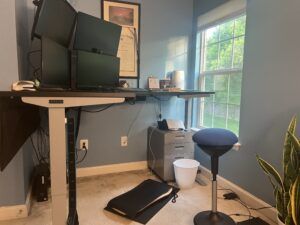Hello, friends! Today, we’re diving into a topic that’s been a personal struggle of mine – shoulder mobility. My journey with shoulder mobility began in earnest this past October when I took up CrossFit, a high-intensity fitness training program. Overhead lifts like the snatch or overhead squat- a staple in CrossFit workouts – and movements such as “kipping” quickly highlighted my shoulder mobility issues. A common phrase to describe the final position of overhead movements is “getting your head through the window,” a challenge I continue to wrestle with.
In the video below, where my mobility issues lie are at the bottom of the squat. My arms want to push forward not straight up making it difficult to support much weight.
My shoulder mobility struggle can likely be traced back to a labrum tear surgery I had on my right shoulder in 2009. The surgery coincided with a very busy period in my/our life – starting a new job after finishing my postdoctoral work, bought a house and the birth of our son (’08). With all this going on, I barely found time to dedicate to proper physical therapy beyond what was essential for daily tasks. A full 12 weeks spent in a sling unsurprisingly impacted my range of motion.
Many years later, I now find myself intent on enhancing my shoulder mobility. Increased shoulder mobility is not only crucial for athletic performance, but it’s also pivotal for overall physical wellbeing. My personal struggles led me to extensively research this topic, a journey I’m happy to share with you. Whether you’re an athlete, a person recovering from an injury, or simply someone interested in boosting your physical health, I believe this guide can help.
Our shoulder is a ball-and-socket joint, designed for diverse motion. This remarkable flexibility allows us to perform a vast range of actions. However, it also makes the shoulder susceptible to injury and stiffness, particularly when it’s not used to its full capacity or if the surrounding muscles are weak or imbalanced.
Importance Of Thoracic Spine Mobility
But here’s something you might not have considered: shoulder mobility isn’t just about the shoulder. It’s also about the thoracic spine – the part of your spine that runs through your upper back. Thoracic spine mobility plays a significant role in shoulder function and overall upper body movement. It allows for proper extension and rotation, crucial for overhead movements. It also influences the movement of your shoulder blades, which sit on your rib cage. If your thoracic spine is stiff and rounded, your shoulder blades can’t move as freely, limiting your ability to fully raise your arms overhead.
Moreover, the thoracic spine serves as a bridge between your lower body and upper body. When you’re doing an overhead squat, force is generated from the lower body and transferred up through a stable core and thoracic spine to the arms and the weight overhead. If your thoracic spine is immobile, it can disrupt this force transfer, reducing the effectiveness of the movement and potentially leading to injury.
So, while we’re focusing on shoulder mobility in this post, I want you to keep in mind that it’s part of a bigger picture. In fact, I’ll be dedicating an entire post to thoracic spine mobility in the future, so stay tuned for that!
In the meantime, here are a few exercises to improve thoracic spine mobility:
Poor shoulder mobility can lead to diminished function, pain, and an increased risk of injuries like shoulder impingement or rotator cuff tears. Hence, it’s imperative to regularly perform exercises that maintain or improve shoulder mobility. Good shoulder mobility can enhance your athletic performance, prevent injuries by allowing your body to move more naturally, and even improve your posture, reducing the likelihood of back pain and other alignment-related issues.
Moreover, for those of us who spend long hours at a desk, often adopting less-than-ideal posture, this can lead to muscle imbalances and restrictions in our shoulder mobility. Pro-tip: Invest in a stand-up desk if you are at a desk all day, its been a game changer for me. However, regularly incorporating shoulder mobility exercises into your routine can help counter some of these negative effects.

In the subsequent sections, I’ll introduce a series of exercises designed to improve your shoulder mobility and strength. These exercises are suitable for individuals at all fitness levels and can easily work into your daily routine. Always remember, it’s never too late to start investing in your shoulder health. Let’s embark on this journey towards improved mobility, greater strength, and an enhanced quality of life.
Assessing Your Shoulder Mobility at Home
Before you start working on improving your shoulder mobility, it’s important to have a baseline understanding of your current mobility level. Here are a few simple tests you can do at home to assess your shoulder mobility. The recommended exercises are explained in detail below (along with video links to further aid demonstration. Remember, these tests are not meant to diagnose any conditions but to give you a general idea of your shoulder mobility.
Wall Angel Test: Stand with your back flat against a wall, with your feet about 6 inches away from the wall. Press your lower back into the wall and try to maintain this contact throughout the test. Extend your arms out to the side at shoulder height and bend your elbows to 90 degrees. Try to touch your elbows and wrists to the wall while keeping your arms at shoulder height. If you can’t touch the wall with your elbows and wrists, or if you have to arch your back to do so, you may have limited shoulder mobility. Recommended Exercise: Wall Slides.
Overhead Reach Test: Lie on your back with knees bent and feet flat. Press your lower back into the ground, maintaining a neutral spine. Reach overhead with both arms simultaneously, keeping elbows locked and thumbs up. Aim for arms to align with your ears, indicating a full 180-degree reach. If one arm outperforms the other or you can’t achieve the full range without bending elbows or arching your back, you may have a shoulder issue. Recommended Exercise: Shoulder Dislocates.
Cross-Body Reach Test: Reach one arm across your body to touch the opposite shoulder blade. Then, reach the other arm up and over your shoulder to touch the opposite shoulder blade. If you can’t reach your shoulder blades or if you feel a significant amount of strain, you may have limited shoulder mobility. Recommended Exercise: Band Pull-Aparts.
Apley’s Scratch Test: This test involves reaching one hand behind your head and down your back and the other hand up your back to try and touch or overlap the fingers of both hands. Difficulty in performing this test can indicate limited shoulder mobility. Recommended Exercise: Doorway Stretch and External Rotation with a Band.
In addition to the general shoulder mobility tests, there are a few specific tests and preparatory exercises that can help determine your readiness for complex movements like the squat snatch and kipping pull-ups:
Overhead Squat Test: The overhead squat is a fundamental part of the squat snatch. To test your mobility for this movement, try performing an overhead squat with a PVC pipe or broomstick. Stand with your feet shoulder-width apart and hold the pipe overhead with a wide grip. Squat down as low as you can while keeping the pipe directly over your midfoot. If you can’t keep your balance, or if your arms move forward, you may need to work on your shoulder and hip mobility. Recommended Exercise: Shoulder Dislocates and Wall Slides.
Hollow and Arch Swing: The hollow and arch swing is a fundamental part of the kipping motion. To test your ability to perform this movement, hang from a pull-up bar and practice alternating between a hollow body position (abs engaged, body slightly rounded) and an arch position (chest up, back arched). If you struggle to maintain these positions or generate momentum, you may need to work on your core strength and shoulder mobility. Recommended Exercise: Scapular Push-ups and Band Pull-Aparts.
Exercises to Improve Shoulder Mobility
Now that we’ve covered the importance of shoulder mobility, let’s dive into some exercises that can help improve it. These exercises are designed to enhance flexibility, increase strength, and improve the range of motion in your shoulders. Remember, consistency is key, and it’s always better to perform these exercises regularly with proper form than to do too many at once. Always warm up before starting these exercises to prepare your muscles and prevent injury.
Shoulder Dislocates: This exercise is great for improving shoulder mobility and flexibility. Stand up straight and hold a resistance band or a broomstick in front of you with a wide grip. Keeping your arms straight, lift the band or stick overhead and then down and behind your back as far as you can go. Return to the starting position and repeat. Start with 2 sets of 10 repetitions.
Wall Slides: Wall slides can help improve shoulder mobility and posture. Stand with your back against a wall, feet shoulder-width apart. Place your arms against the wall in a ‘W’ shape. Slide your arms up the wall into a ‘Y’ shape, keeping your back and arms in contact with the wall. Slide back down into the ‘W’ shape and repeat. Start with 2 sets of 10 repetitions.
Band Pull-Aparts: This exercise strengthens the muscles in your upper back and shoulders. Stand up straight and hold a resistance band in front of you at chest height with both hands, arms fully extended. Keeping your arms straight, pull the band apart by moving your arms out to the sides. Return to the starting position and repeat. Start with 2 sets of 10 repetitions.
Scapular Push-ups: This exercise strengthens the muscles around your shoulder blades, which are crucial for movements like pull-ups. Start in a high plank position with your hands directly under your shoulders. Keeping your arms straight, lower your body by letting your shoulder blades come together. Push your body back up by spreading your shoulder blades apart. Repeat for 2 sets of 10 repetitions.
Doorway Stretch: This stretch can help improve mobility and flexibility in your chest and shoulders. Stand in an open doorway. Lift your arm so it’s parallel to the floor and bend at the elbow so your fingers point toward the ceiling. Place your hand on the doorjamb. Slowly lean into your raised arm and push against the doorjamb for 10-15 seconds. Repeat with the other arm.
External Rotation with a Band: This exercise strengthens the rotator cuff muscles, which are important for shoulder stability. Stand up straight and hold a resistance band with both hands in front of you at waist height. Keeping one arm still, rotate the other arm outward while keeping it bent at a 90-degree angle. Return to the starting position and repeat. Do 2 sets of 10 repetitions on each side.
The Long Journey of Improving Shoulder Mobility
Improving shoulder mobility is a journey that requires patience, diligence, and consistency. I struggle with the patience part but I’m going to give it a go. I know that decades of immobility won’t be erased in a few weeks of work.
Exercising Mindfully and Avoiding Pain
Remember, these exercises should never cause pain. If you feel pain while doing any of these exercises, stop immediately. It might indicate that you’re doing the exercise incorrectly or that there’s an underlying issue that needs to be addressed. Don’t be discouraged if you can’t perform these exercises perfectly at first. With practice and patience, your mobility will likely improve over time.
The Role of Posture and Movement
Another critical aspect of improving shoulder mobility is being aware of your posture throughout the day, especially if you spend a lot of time sitting or if you perform repetitive movements that could lead to imbalances or stiffness. Take regular breaks to stretch and move around. Your body will thank you for it.
Personalizing Your Mobility Journey
Above all, it’s crucial to listen to your body and understand that everyone’s mobility journey will be unique. What works for one person might not work for another. Your journey should be personalized to your needs and capabilities, and it’s okay to adjust your approach as you go along. The ultimate goal is not to achieve a specific milestone but to enhance your overall physical wellbeing and quality of life.
Disclaimer
Finally, remember that this guide is not intended to replace professional medical advice, diagnosis, or treatment. Always seek the advice of your physician or another qualified health provider with any questions you may have regarding a medical condition. Never disregard professional medical advice or delay in seeking it because of something you have read on this blog.
Feature Image by Drazen Zigic on Freepik



